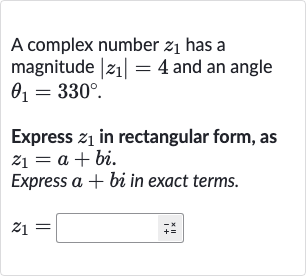Full solution
Q. A complex number has a magnitude and an angle .Express in rectangular form, as .Express in exact terms.
- Conversion formula: To express a complex number in rectangular form, we use the polar to rectangular conversion formula, which is , where is the magnitude and is the angle in radians.
- Convert angle to radians: First, we need to convert the angle from degrees to radians because the trigonometric functions in the formula require the angle to be in radians. The conversion is done by multiplying the degree measure by . in radians =
- Calculate cosine and sine: Now we can calculate the cosine and sine of in radians. and
- Substitute values into formula: Using the unit circle or trigonometric identities, we know that and , since is in the fourth quadrant where cosine is positive and sine is negative.
- Simplify expression: The exact values for and are and , respectively. Therefore, = and = .
- Simplify expression: The exact values for and are and , respectively. Therefore, and .Now we can substitute the values of , , and into the formula to get the rectangular form of .
- Simplify expression: The exact values for and are and , respectively. Therefore, and .Now we can substitute the values of , , and into the formula to get the rectangular form of .Simplify the expression to get the final rectangular form of .

